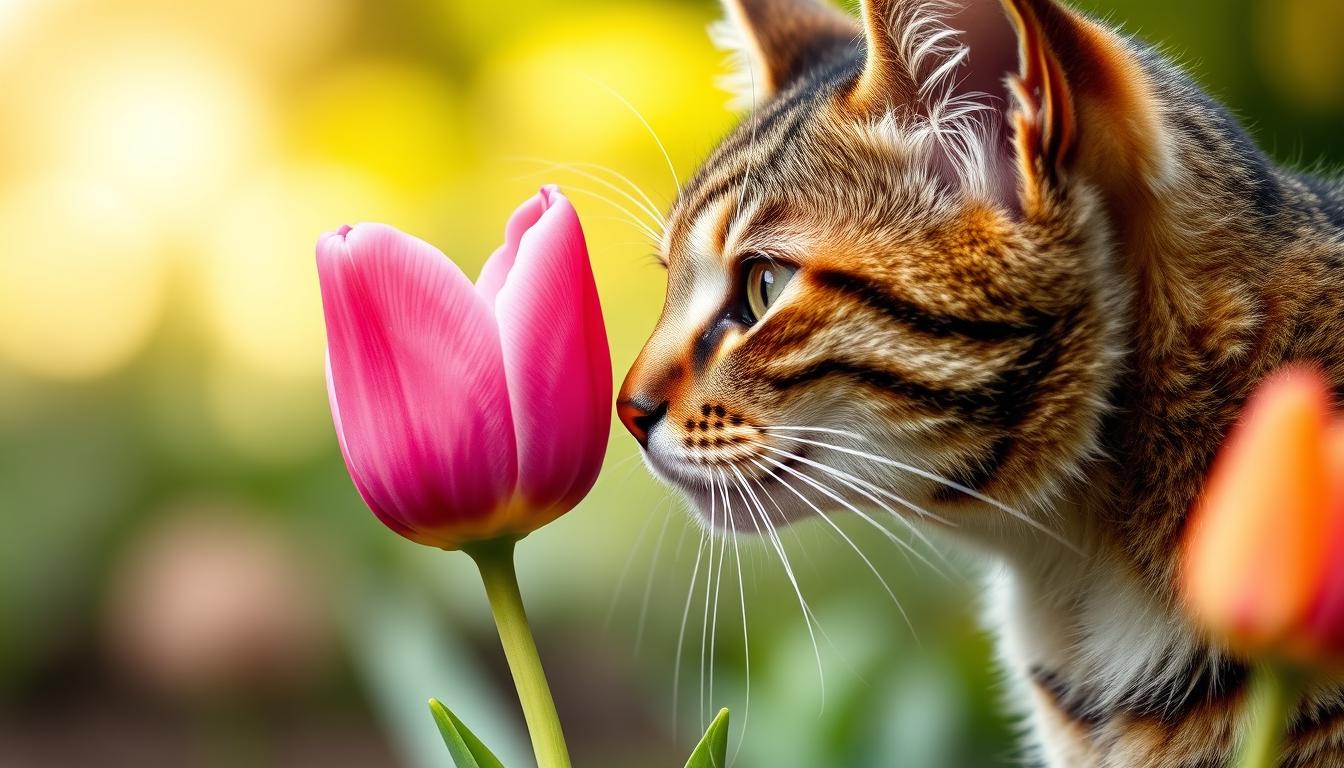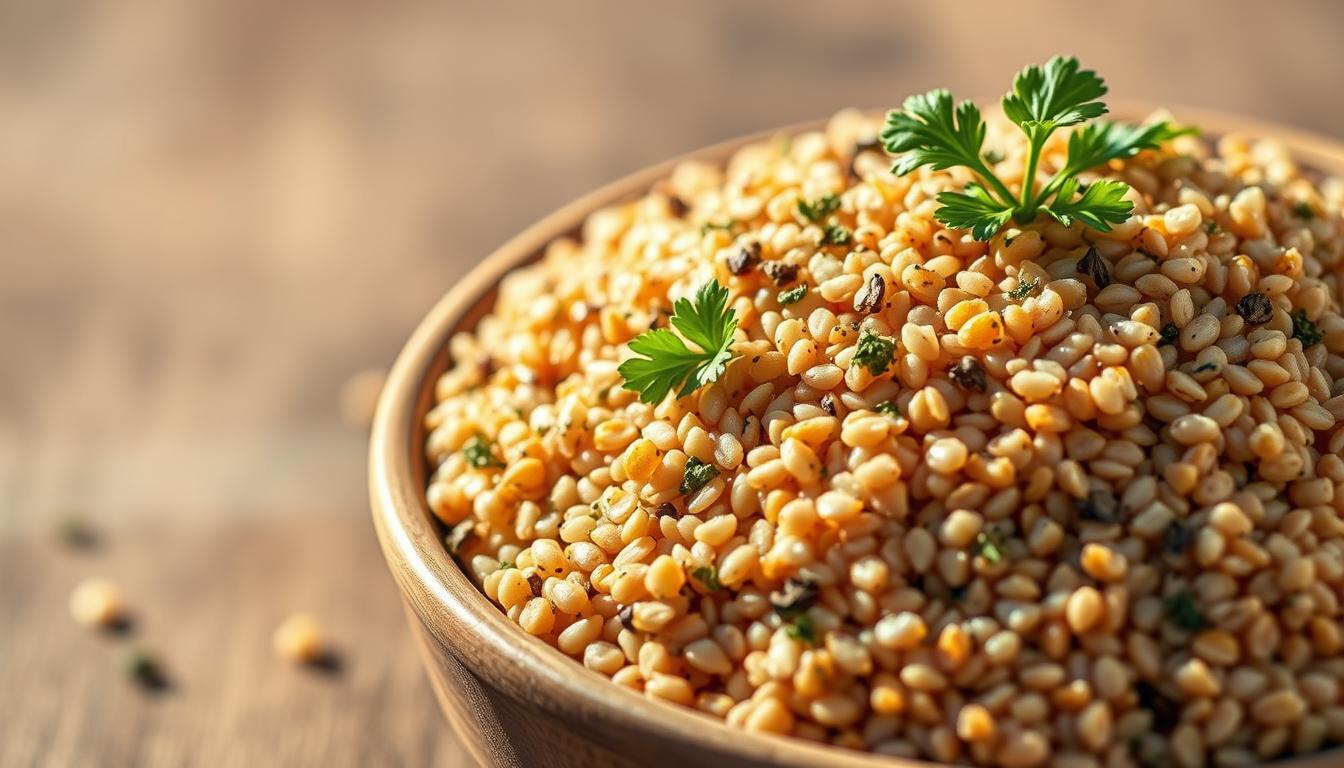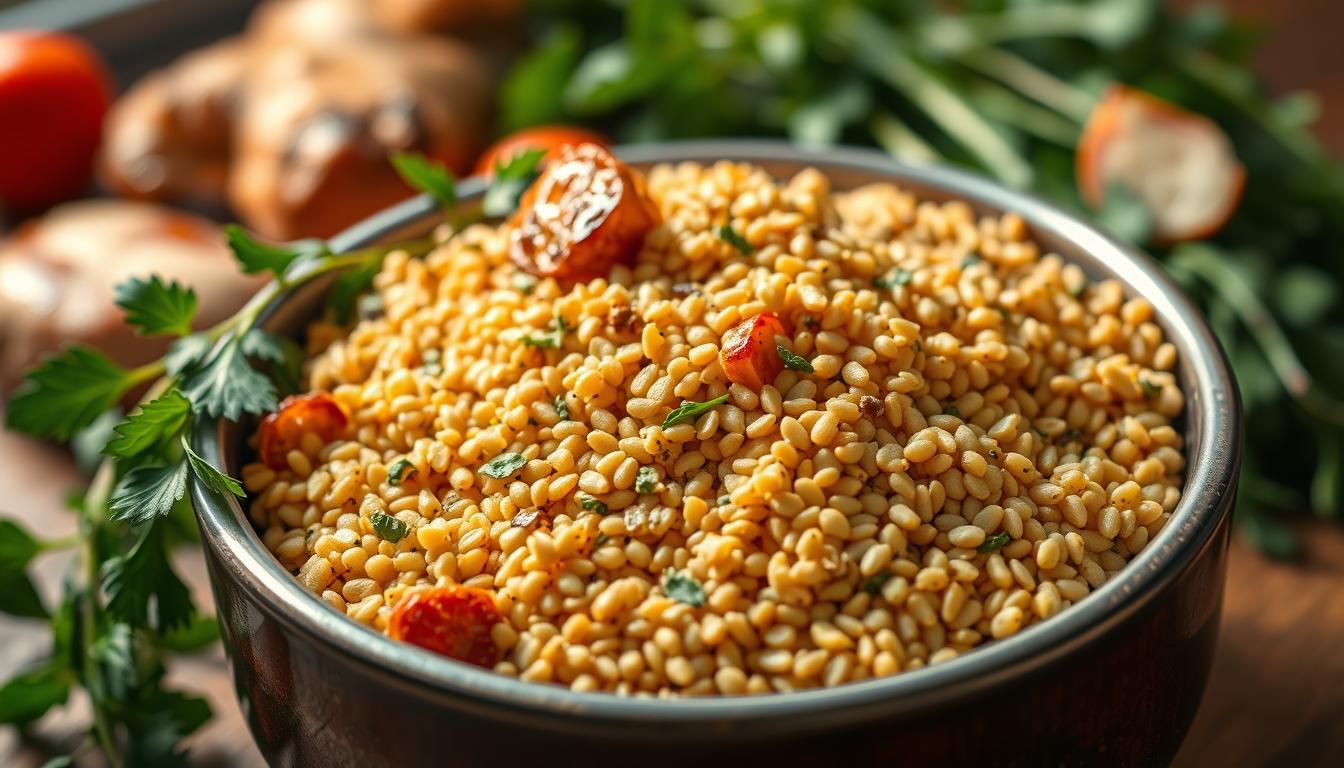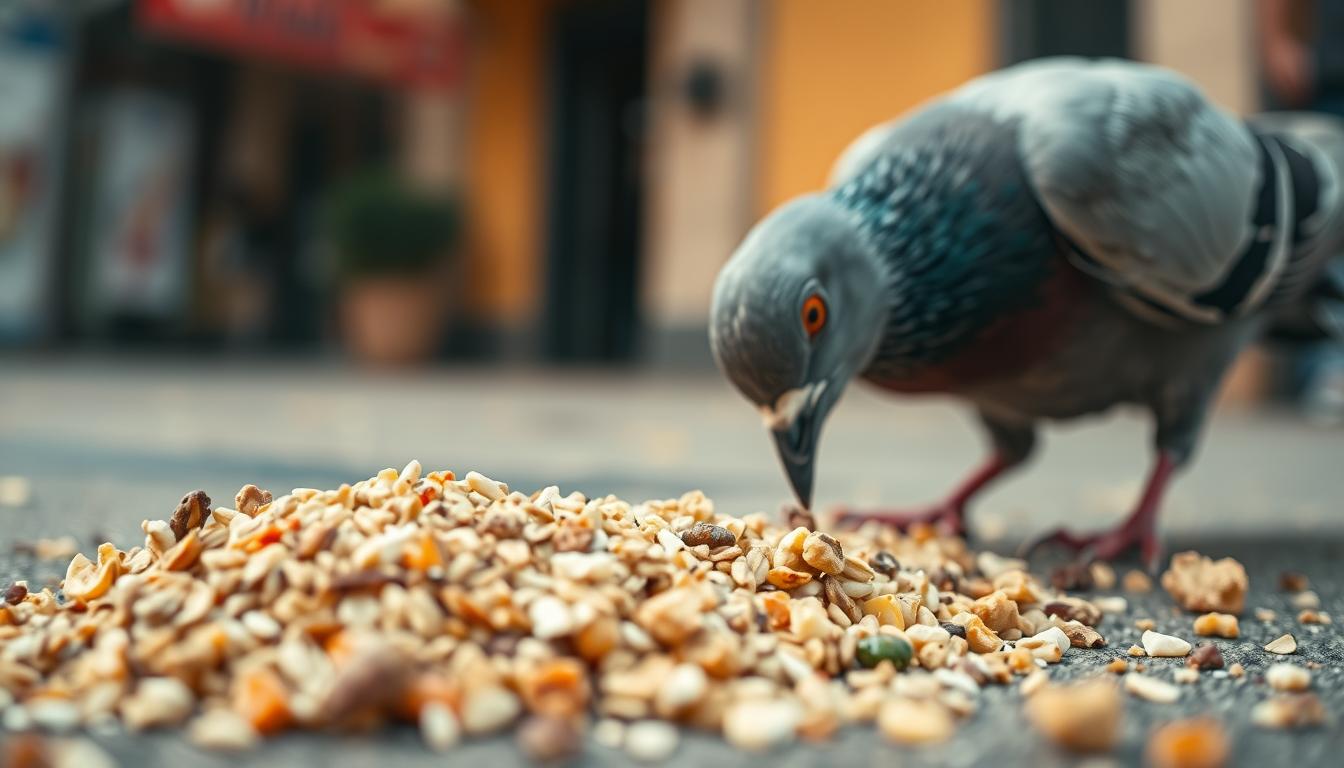You love your feline friend, but did you know that those beautiful tulips in your garden could be a silent killer? Are tulips safe for cats? The short answer is a resounding no. Cat tulip toxicity is a serious concern for pet owners across the United States.
Every spring, millions of pet owners unknowingly bring potential danger into their homes. With approximately 86.9 million homes owning pets, the risk of plant-related accidents is alarmingly high. Tulips, part of a list of 17 common flowers toxic to cats, can cause severe health complications.
Imagine coming home to find your beloved cat suffering from plant poisoning. The thought alone is heartbreaking. This article will guide you through the critical information about tulips and your cat’s safety. It will help you create a pet-friendly environment that protects your furry companion from hidden dangers.
Table of Contents
Understanding Tulip Toxicity in Cats
Keeping your cat safe is very important. Tulips might look pretty, but they can be harmful to curious cats. Cats might want to explore these colorful plants.
Eating tulips can cause serious health problems for cats. The Tulipa genus has toxic compounds. Some parts of the plant are more dangerous than others.
Toxic Compounds in Tulips
Tulips have two main toxic alkaloids. These make them dangerous for cats:
- Tulipalin A
- Tulipalin B
Most Dangerous Plant Parts
Not all tulip parts are equally toxic. But, cat owners should know this:
- Bulbs: Have the most toxic compounds
- Leaves: Are moderately toxic
- Stems: Are less toxic but still risky
Understanding Toxicity Levels
The severity of tulip poisoning depends on a few things:
- How much plant material is eaten
- The cat’s size and health
- Which part of the plant is eaten
Cats eating small amounts might show mild symptoms. These include drooling, vomiting, and diarrhea. Eating a lot can cause serious problems. This includes organ damage and seizures.
Signs Your Cat Has Ingested Tulips
It’s important to know the signs of tulip poisoning in cats. Tulips are toxic to cats and can cause serious health issues. If your cat eats any part of a tulip plant, they might show several warning signs.
Some common symptoms of tulip poisoning in cats include:
- Excessive drooling
- Vomiting
- Diarrhea
- Mouth and throat irritation
- Loss of appetite
- Unusual weakness or lethargy
More severe cases of tulip poisoning can lead to:
- Difficulty breathing
- Tremors or seizures
- Increased heart rate
- Potential liver or kidney damage
The severity of symptoms depends on how much tulip your cat eats. Eating small amounts might cause mild stomach upset. But eating bulbs can lead to serious health problems. If you think your cat ate a tulip, call your vet right away.
Every part of the tulip plant is toxic to cats, but bulbs are the most dangerous. Quick action and medical help can greatly improve your cat’s chances of recovery.
Are Tulips Safe for Cats: What Every Owner Must Know
Pet owners need to know the dangers tulips pose to cats. These beautiful flowers can be harmful to your cat’s health. Their bright colors hide toxic compounds that can cause serious harm.
Cats are drawn to bright plants and flowers. Unfortunately, tulips are not safe for them. Every part of the tulip plant has harmful chemicals that can lead to serious health issues.
Immediate Dangers
When cats touch tulips, they face serious health risks right away. The main dangers include:
- Intense gastrointestinal distress
- Sudden onset of vomiting
- Persistent diarrhea
- Excessive drooling
- Potential mouth and throat irritation
Long-term Health Effects
Exposure to tulips can lead to long-term health problems. Repeated or significant exposure can cause:
- Potential organ damage
- Weakened immune system
- Chronic digestive issues
- Neurological complications
Risk Factors in Home Gardens
Your home garden can be a danger zone for curious cats. Tulip bulbs are especially dangerous, with high levels of toxic compounds. Outdoor gardens with tulips need careful management to keep pets safe.
Always put your cat’s safety first by removing tulips from their reach. If your cat gets exposed, seek a vet’s advice.
Emergency Steps If Your Cat Eats Tulips
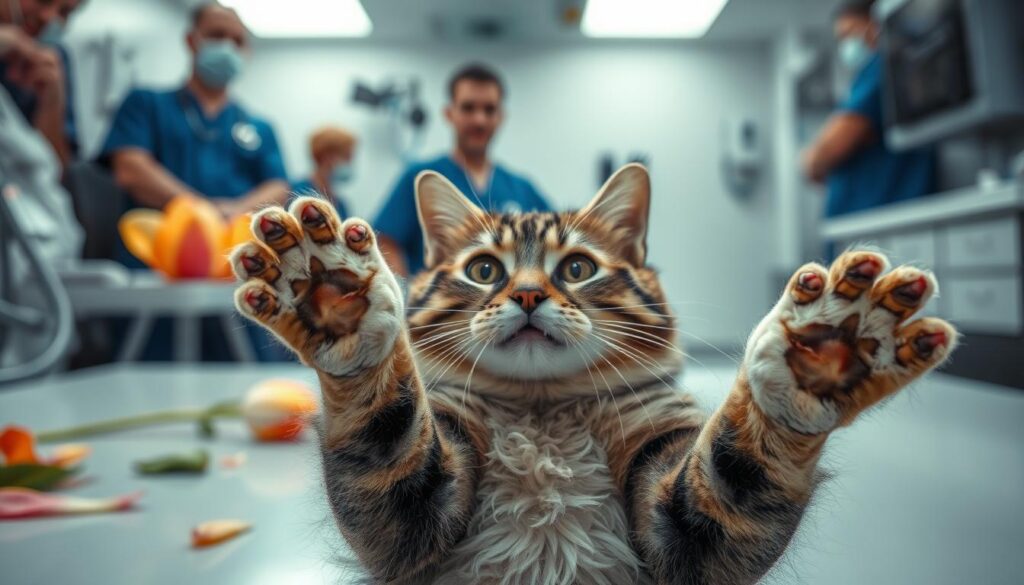
Seeing your cat eat tulips can be very scary. It’s important to act fast to protect their health.
If you think your cat has eaten tulips, here’s what to do:
- Take any plant parts out of your cat’s mouth
- Look for signs like:
- Too much drooling
- Vomiting
- Feeling very tired
- Having trouble breathing
- Call your vet right away
- Save any plant pieces for your vet to look at
Your vet wants to see your cat as soon as possible. Don’t wait for things to get worse. Quick action can help avoid serious problems.
They might do things like:
- Make your cat vomit
- Give them activated charcoal
- Give fluids through an IV
- Watch them closely
It’s always safer to keep tulips and other harmful plants away from your cat. This way, you can avoid emergencies.
Prevention Strategies for Cat Owners
To keep your cat safe from toxic plants, you need to be proactive. Knowing how to make your home safe can greatly lower the chance of plant poisoning.
Using good cat gardening tips can help you make a safe space. This way, your curious cat won’t get near dangerous plants like tulips.
Creating Safe Garden Spaces
When you design your garden, think about these safety tips:
- Create physical barriers around toxic plants using decorative fencing
- Designate specific cat-free zones in your garden
- Use raised planters to keep dangerous plants out of reach
- Replace toxic plants with cat-friendly alternatives
Indoor Plant Placement Tips
Indoor plants need careful placement for cat safety:
- Position toxic plants on high shelves or hanging planters
- Use protective plant stands with barriers
- Keep plants in rooms that can be closed off from your cat
- Monitor your cat’s interaction with indoor greenery
Training Your Cat to Avoid Plants
Teaching your cat to stay away from plants is a good idea. Use positive methods like:
- Redirecting your cat with interactive toys
- Using pet-safe deterrent sprays
- Providing alternative stimulating environments
- Rewarding your cat for staying away from plants
Remember, consistent training and careful plant placement are crucial. They help keep your cat safe from plant dangers.
Why Cats Are Attracted to Tulips
Your curious feline might find tulips unexpectedly fascinating. Cats are naturally drawn to plants for various intriguing reasons. Understanding cat tulip toxicity can help protect your furry friend from potential dangers.
Cats typically become attracted to tulips through several sensory triggers:
- Bright, vibrant colors that catch their eye
- Soft, delicate petals with interesting textures
- Subtle movements when leaves or flowers sway
- Unique plant scents that stimulate their keen sense of smell
The question of are tulips safe for cats has a critical answer: they are absolutely not. Despite their attractive appearance, tulips contain toxic compounds that can harm your pet. Cats might be drawn to these plants out of curiosity or playful instinct, not understanding the potential health risks.
Feline behavior experts suggest that cats are naturally exploratory creatures. Their hunting instincts and environmental curiosity lead them to investigate new objects, including plants. The delicate structure of tulips can mimic prey movement, making them especially enticing to your cat.
To keep your cat safe, always supervise their interactions with plants and create barriers between your pets and potentially toxic greenery. Remember, prevention is always better than treatment when it comes to cat tulip toxicity.
Safe Alternatives to Tulips for Cat Owners
Keeping your cat safe doesn’t mean giving up on beautiful plants. You can have stunning gardens and indoor spaces with pet-safe flowers. These blooms add color and life without harming your cat.
Cat-Friendly Flowers to Brighten Your Space
Find 11 gorgeous cat-friendly flowers to make your home beautiful and safe:
- Roses – classic and elegant
- African violets – delicate and compact
- Orchids – exotic and sophisticated
- Gerbera daisies – cheerful and vibrant
- Snapdragons – unique and colorful
- Zinnias – bright and easy to grow
- Sunflowers – tall and striking
- Freesias – fragrant and delicate
Non-Toxic Garden Options for Feline Safety
Your outdoor space can be both beautiful and safe for pets. Plant these 20 non-toxic plants for a cat-friendly garden. Cat grass is great, offering a safe snack with oat, wheat, barley, and rye grass.
Indoor Plant Alternatives for Cat Owners
If fresh flowers aren’t an option, try silk flowers, dried arrangements, or faux succulents. These options are safe and keep your home looking good.
Use shelves or hangers to place plants. Also, citrus sprays can help keep cats away from your safe blooms.
Seasonal Dangers: Spring Flowers and Your Cat

Spring brings beautiful flowers that can be deadly for curious cats. Gardening and enjoying nature seem safe, but many flowers are toxic to cats. This makes cat plant safety very important for pet owners.
The most dangerous spring flowers for cats include:
- Tulips
- Daffodils
- Lilies
- Azaleas
These plants have harmful compounds. Calcium oxalate crystals and other toxins can cause serious health problems. Cats may get sick, vomit, have diarrhea, and even face kidney failure or seizures.
When gardening in spring, keep your cat safe. Here are some tips:
- Check if a plant is toxic before buying it
- Put barriers around harmful plants
- Choose plants that are safe for pets
- Watch your cat when they’re outside
Preventing harm is crucial for your cat’s safety. A little curiosity can lead to a big problem. So, be careful and make a safe space for your cat in the beautiful spring season.
Creating a Cat-Safe Garden Environment
Creating a safe garden for your cat needs careful planning. With the right tips, your garden can be beautiful and safe for your pet.
Begin by picking flowers that are safe for cats. Make sure to have areas that keep your garden and cat safe.
- Choose non-toxic plants specifically safe for cats
- Create physical barriers around potential hazard zones
- Use natural deterrents to keep cats away from dangerous plants
- Provide alternative stimulating spaces like cat trees or scratching posts
Understanding your cat’s behavior is key to good garden design. Cats are naturally curious. So, it’s important to make safe and interesting spaces for them. Think about using raised beds or enclosed areas for them to explore safely.
Smart landscaping can help too. For example:
- Placing toxic plants in elevated containers
- Using decorative fencing
- Applying natural repellents around sensitive garden areas
Keep an eye on your garden to make sure it stays safe for your cat. With some planning, you can make a beautiful outdoor space that’s perfect for your pet.
Conclusion
Knowing if tulips are safe for cats is key for pet owners. Tulips can be harmful, causing anything from mild stomach issues to serious breathing problems. Keeping your cat safe means being aware of the dangers in these flowers.
Keeping your home safe for cats means avoiding tulips. Instead, choose plants like spider plants or Boston ferns. These are safer for your cat. Also, make sure to get your cat to the vet right away if they eat something they shouldn’t.
Not all plants are dangerous for cats. While tulips can be harmful, there are many safe plants for your home. Learn about these plants and watch your cat closely to keep them safe.
Preventing problems is the best way to keep your cat healthy around plants. Stay up to date, act quickly, and talk to your vet if you think your cat has eaten something bad.
FAQ
Are tulips toxic to cats?
Yes, tulips are very harmful to cats. The bulbs, in particular, have toxic compounds called tuliparin. These can cause serious health problems if cats eat them.
What makes tulips dangerous for cats?
Tulips have toxic alkaloids and glycosides. These can hurt a cat’s digestive system a lot. The bulbs have the most of these toxins, making them especially risky.
What symptoms should I watch for if my cat has eaten tulips?
Look for signs like a lot of drooling, vomiting, and diarrhea. Cats might also have trouble breathing, a fast heart rate, and stomach pain. In bad cases, they could shake, have seizures, or heart problems.
How quickly can tulip poisoning affect my cat?
Symptoms can show up in 2-6 hours after eating tulips. How fast it happens depends on how much they ate and what part of the plant. Bulbs are the worst.
What should I do if my cat eats a tulip?
Call your vet or an animal poison control center right away. Don’t wait for symptoms to show. If you can, bring a piece of the plant or take a photo to help identify it.
Are some cats more at risk than others?
Young cats and those with health issues are more likely to get sick from tulips. Indoor cats who like to explore plants are also at high risk.
What are some safe flower alternatives for cat owners?
Safe flowers for cats include roses, orchids, sunflowers, and African violets. These plants are not toxic and can be safely kept around cats.
Can cats be trained to avoid toxic plants?
Cats can be trained, but it’s not always effective. The best way to protect them is to remove toxic plants. You can also use safe alternatives or sprays with citrus scents to keep them away.
How long does tulip poisoning treatment take?
Treatment can last from 24 to 72 hours, depending on how bad the poisoning is. Some cats might need to stay in the hospital and get extra care to get better.
Are dried or cut tulips still dangerous?
Yes, dried or cut tulips are still toxic. Even a little bit can harm cats. So, it’s best to keep all tulip products away from pets.
Source Links
- No title found – https://www.lemon8-app.com/@essence.pets/7419842271656575493?region=us
- 10 Springtime Hazards Cat Owners Need to Be Aware of (Vet Approved) – Catster – https://www.catster.com/lifestyle/springtime-hazards-for-cats/
- 6 Vet-Approved Home Remedies for Treating Cat Wounds | PangoVet – https://pangovet.com/pet-health-wellness/cats/home-remedies-to-treat-cat-wounds/
- 18 Common Plants Poisonous to Cats – https://be.chewy.com/which-plants-are-poisonous-to-cats-a-complete-guide/
- Are Tulips Toxic To Cats And Dogs – DutchGrown – https://www.dutchgrown.co.uk/blogs/news/are-tulips-toxic-to-cats-and-dogs-dutchgrown
- Are Tulips Toxic to My Cat? Toxic Plants to Cats – https://www.kinship.com/cat-health/are-tulips-toxic-for-cats
- 🌷 Are Tulips Harmful to Cats? – https://www.thesprucepets.com/are-tulips-toxic-to-cats-8619230
- Will My Cat Get Sick if They Are in the Same Room as Tulips? – https://dwellect.com/are-tulips-toxic-to-cats/
- Tulips May Beautify Your Home, but They’re Poisonous for Your Cats — Details Here – https://www.greenmatters.com/pets/are-tulips-toxic-to-cats
- Are Tulips Toxic to Cats? – The Environmental Blog – https://www.theenvironmentalblog.org/2024/10/are-tulips-toxic-to-cats/
- Cat Owner Guides: Which flowers are toxic to cats? – https://www.cheshireandwain.com/blogs/journal/cat-owner-guides-what-flowers-are-toxic-to-cats-1?srsltid=AfmBOoruE-DK8BDNwJrUyk8Tt0bDmcqrEi4RibUVPqDlCD2mC0RVhH3S
- Tulipa spp. Danger: Assessing Tulip Toxicity in Cats – https://www.journeysmobilevet.com/are-tulips-toxic-to-cats/
- These everyday things can be poisonous to cats – https://www.lovemycatz.com/health/poisonous-to-cats/
- Are Tulips Toxic to Cats? Vet-Reviewed Facts & FAQ | PangoVet – https://pangovet.com/pet-health-wellness/cats/are-tulips-toxic-to-cats/
- Keeping Your Pets Safe – Morris Animal Refuge – https://morrisanimalrefuge.org/2025/03/05/national-pet-poison-prevention-month-keeping-your-pets-safe/
- Are Tulips Toxic to Animals? – https://tascllc.com/en/blog/are-tulips-toxic-to-animals-137?srsltid=AfmBOoqdmP2NRne2SdGjPJzOo9iG4Bz7X9c0ZUoNVQOjEpsCci7A3NAp
- Non-Toxic Flowers That Are Safe for Cats—and Toxic Flowers – https://www.kinship.com/cat-health/flowers-safe-for-cats
- Plants Poisonous to Cats | 11 Dangerous Garden Species – https://homeandroost.co.uk/blogs/cats/plants-poisonous-to-cats?srsltid=AfmBOoq0KTT_uzp_Q9Pf8ZZ3GvQz_BfBRcu37zOUvEMFfGPAIFotAL0y
- 31 Cat-Safe Plants and Flowers – https://www.petmd.com/cat/general-health/plants-safe-for-cats
- Cat Owner Guides: Which flowers are toxic to cats? – https://www.cheshireandwain.com/blogs/journal/cat-owner-guides-what-flowers-are-toxic-to-cats-1?srsltid=AfmBOooZMBsi5qurIHVIer58L3IxUehlroTeNT8JFZsJA1zHKRYbH_M8
- Flora | Flowers Safe for Cats: A Guide to Cat-Friendly Blooms – https://florasense.com/blogs/flowers-safe-for-cats-a-guide-to-cat-friendly-blooms/
- Springtime Safety: A Guide to Keeping Cats Safe from Seasonal Hazards | The Cat Butler – https://www.thecatbutler.co.uk/cat-care-guides/springtime-safety-a-guide-to-keeping-cats-safe-from-seasonal-hazards/
- Are tulips toxic to cats? Experts warn to keep these springtime favorites away from felines – https://www.homesandgardens.com/gardens/are-tulips-toxic-to-cats
- Cats and Summer Plants: Creating a Feline-Friendly Garden — The Hervey Foundation for Cats – https://www.herveycats.com/blog/cats-and-summer-plants-creating-a-feline-friendly-garden
- Are Tulips Toxic to Cats? Symptoms, Diagnosis & Tips by Veterinary – Eternity Flower® – https://www.eternityflower.com/blogs/news/are-tulips-toxic-to-cats?srsltid=AfmBOoq7OpTuhhbqkpTcxRz1xuna8tnb1Ta2r07qqEO-CiE7CtBPVb69
- Can Cats Eat Tulips? Important Safety Facts (Vet Reviewed) | Hepper – https://www.hepper.com/can-cats-eat-tulips/
- What Flowers Are Dangerous to Cats? 7 Vet-Verfied Threatening Plants – Catster – https://www.catster.com/cat-health-care/what-flowers-are-dangerous-to-cats/

